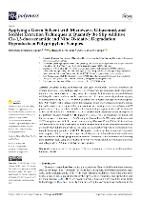Resumen
Erucamide is used as an important slip agent for polymers. However, erucamide can
degrade during processing and long-term storage, forming various oxidation products. These degra dation products can affect the recovery rates of erucamide. In this study, investigated different
solid–liquid extraction methods (Soxhlet, microwave, and ultrasound) and used gas chromatography
with mass spectrometry (GC-MS) to quantify erucamide and its degradation byproducts in polypropy lene (PP). A multivariable experiment was designed, and a mixed-effect approach was used to analyze
the results. Various extraction variables were examined, such as temperature, time, solvents, and PP
pretreatments. Using a mixed-effect model with a Kenward–Roger approximation, an R2 of the model
of 97% and p values of 0.168, 0.000, and 0.000 were obtained for the technical, solvent, and type of PP
pretreatment variables, respectively. The highest average recoveries of erucamide were found with
the microwave technique and were 96.4% using dichloromethane, 94.57% using cyclohexane, and
93.05% using limonene. With ultrasound, recoveries ranged between 85 and 92% for dichloromethane
and limonene. In addition, it was observed that the extraction method had better recovery results in
ground PP than in films and in pellets. Nine oxidative degradation byproducts of erucamide were
identified and semi-quantified by GC-MS. The reaction mechanisms for forming each byproduct
were proposed. The byproducts that experienced a higher rate of degradation of erucamide were
erucamide with a hydroxyl group at position one and 12-amino-6-12-oxo-dodecanoic acid, showing
more prominent peaks using the Soxhlet method with cyclohexane and dichloromethane as solvents
and polypropylene (PP) films as the type of material used.














